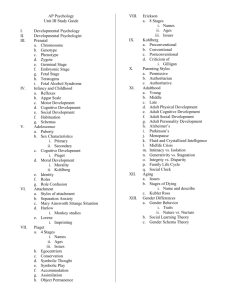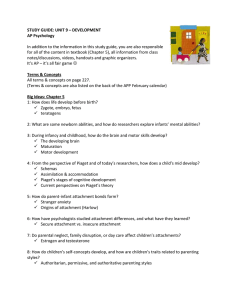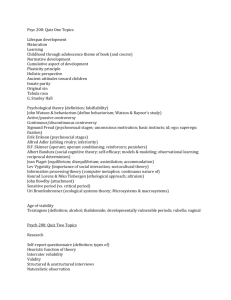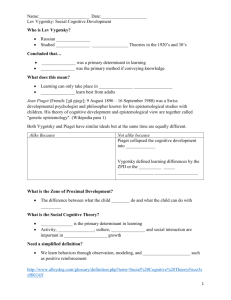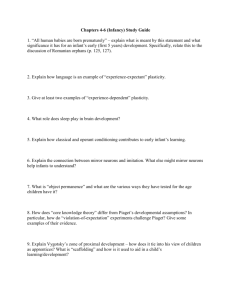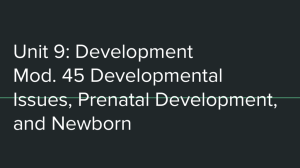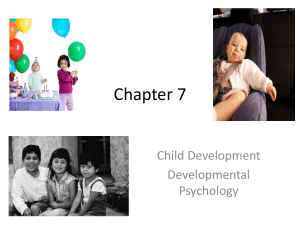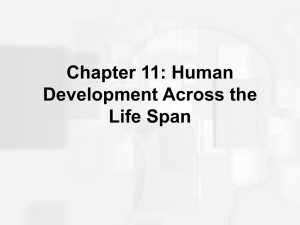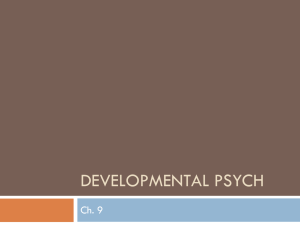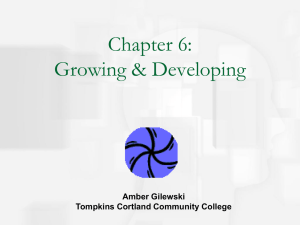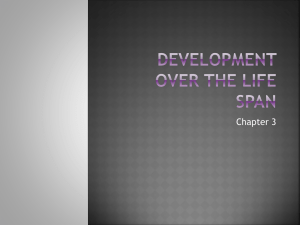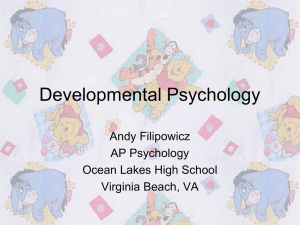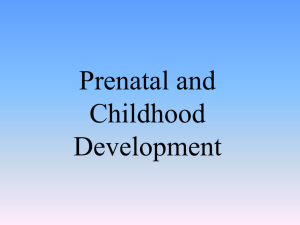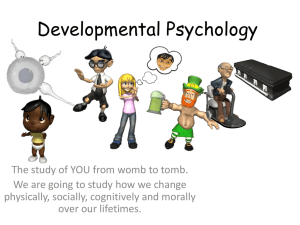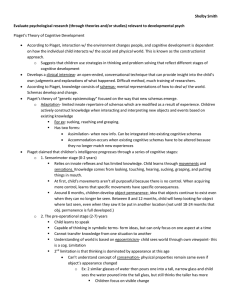Childhood Development
advertisement
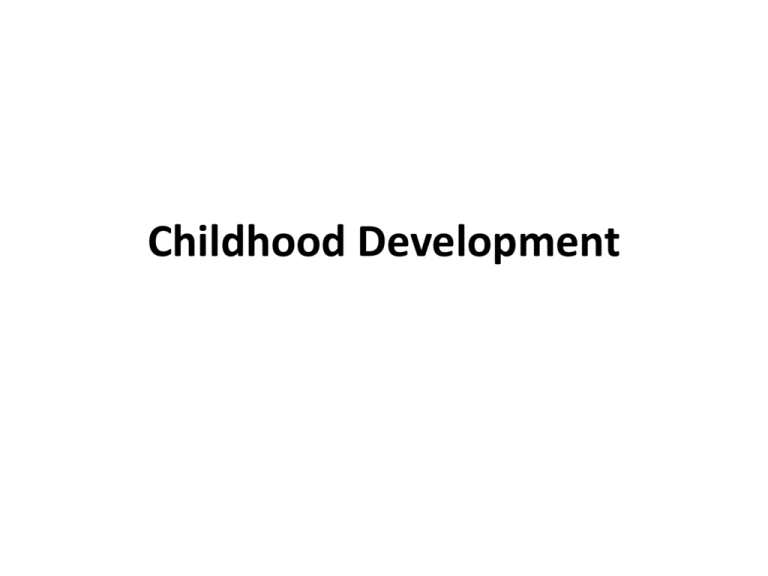
Childhood Development Prenatal Development Concerns/Issues 1. Use of teratogens: substances taken by the mother that can have a detrimental effect on the child during development in the uterus. Examples: thalidomide, fetal alcohol syndrome (FAS). 2. Maternal nutrition/exposure to toxins. 3. Fetal origins of disease 4. Congenital illnesses (e.g. cerebral palsy) Temperament • Landmark studies by Alexander Thomas and Stella Chess identified three types of temperament seen in young children. 1. Easy: happy, regular in sleep/eat 2. Slow-to-warm up: difficulty adjusting 3. Difficult: glum, irritable. Temperament styles in three-month old babies stayed stable over the next decade. Temperament Jerome Kagen (1991, 1992) found that children vary in willingness to approach strangers 15-20% inhibited 20-25% uninhibited Rest in between Those who displayed inhibition more likely to have anxiety disorders in adolescence/adulthood (Kagen, 2008) Cognitive Development (i.e. thinking) Throughout early childhood, children change: • 1. in the amount that they learn • 2. in their manner of thought Jean Piaget: Considered the pioneer in discovering how children’s learning abilities change over time. Jean Piaget • Every person possesses schemas, which are ways that we mentally understand the world. • When new info comes into our pre-existing schemas, we work to adapt that info by: • assimililation: fitting new info into the schema, or • accommodation: change the schema to fit the info • Both methods help the intellect develop Piaget’s Theory of Development 1. Sensorimotor (birth>18 months) • Motor responses to info (stimuli) • Senses primary way of exploring world • Does not understand concept of object permanence 2. Preoperational (18 months> 7yrs) • -Lacks ability of reversibility • -Egocentric in thought • -Simple symbolic thought arises Piaget’s Theory of Development 3. Concrete operations(7>11 yrs) • -Understands idea of conservation (the ability to question perception) • -Can classify objects • -Difficult to think abstractly (what if, complex math) • - What about Santa/EB/Tooth Fairy? 4. Formal operations (11 yrs>up) • Understanding of the abstract and hypothetical • Can think logically Criticisms of Piaget 1. Research shows that Piaget underestimated ability of children to master concepts, especially object permanence. 2. Rather than having distinct stages of development, children display behaviors that go across two or more stages. 3. While research generally support Piaget’s stages of development, children are not uniform in how long they take in the stages. 4. Underestimation of the role of environment. Sociocultural Theory • Developed by Lev Vygotsky (1896-1934), in U.S.S.R. • Theory unknown in the West until the 1960s, and not fully known until the 1980s. • Vygotsky believed that children learn primarily from other people (parents, older siblings, caretakers) • Culture plays a key role in development, making the development non-universal • Acquisition of language plays a vital role in cognitive development, which can be seen when young children talk to themselves (private speech). • “Through others we become ourselves.” MKO and ZPD • Vygotsky developed two terms to demonstrate how cognitive development took place • More Knowledgeable Other: The person/entity who possesses more ability/skill than the learner. Under the theory, the teacher can be a thing (e.g. computer). • Zone of Proximal Development: the difference in time between a task can be completed by a learner with an MKOs help, compared to the time taken if the learner does the task independently. Cognitive Development Research • Recent research (Rowe & Goldin-Meadow, 2009) indicate that children at 14 months whose parents demonstrate large amounts of “gesture” language will: -have larger gestures than those children who did not gesture as often; and -will have a larger vocabulary at 4.5 years - research also found that parents from a higher socioeconomic classes use gestures more often - And… • “The more that you read, the more things you will know. The more that you learn, the more places you’ll go.” • Dr. Seuss (summary: read to your children) What about: • 1. Baby Einstein/Classical Music? • 2. Television? Emotional Development • Konrad Lorenz: The idea of imprinting: that certain responses are inherited and of critical period: crucial time where certain skills abilities are most easily learned. • -Think about the Genie video • Harry Harlow: Experiments with monkeys showed that the monkeys sought and needed contact. • Studies suggest that attachment to the mother especially strong from 6-36 months. Ainsworth: Levels of Attachment Using a method known as the strange situation procedure, Mary Ainsworth used a series of different separation/reunion scenarios to gauge the level of mother-child attachment. Results: 1. Most children were examples of secure attachment, using their mother as a base to explore their surroundings. Children upset when she leaves, but comforted when she returns. Ainsworth, continued 2. A smaller number showed anxious-ambivalent attachment. Anxious when mother is present, very upset when she leaves, not comforted by return. 3. Some are avoidant attachment. Not seeking mother when she is there, not upset by her absence. 4. Over a decade after initial research, the disorganizeddisoriented was added to describe children who appeared confused over to approach or avoid the mother. These children are typically insecure (LyonsRuth & Jacobvitz, 2008) Additional Development Theories 1. Freudian Psychosexual Theory 2. Eric Erikson: Psychosocial • -individuals seek to acquire social goals throughout their life Examples: • (1-3) Independence v. Dependence • (6-12) Identity v. role confusion • (Young adult) Intimacy v. Isolation • (Old Age) Ego integrity v. despair Additional Development Theories 3. Cognitive-Developmental Theory: Learning through doing. • The importance of play. Play is used as a training ground for the adult world. • “Everything I needed to learn I learned in kindergarten.” • - recent findings (Dyson, 2009) support that young school-age children learn best by having the opportunity to manipulate their environment around them. • Additional Development Theories 4. Lawrence Kohlberg: Moral Development: Developing an individual sense of right and wrong. - According to Kohlberg, people evolve from behaving according to obedience to authority, to behaving based on what is best for overall society. - Criticized by Carol Gilligan as too male-oriented, and too focused on ideas of social justice v. caring.
